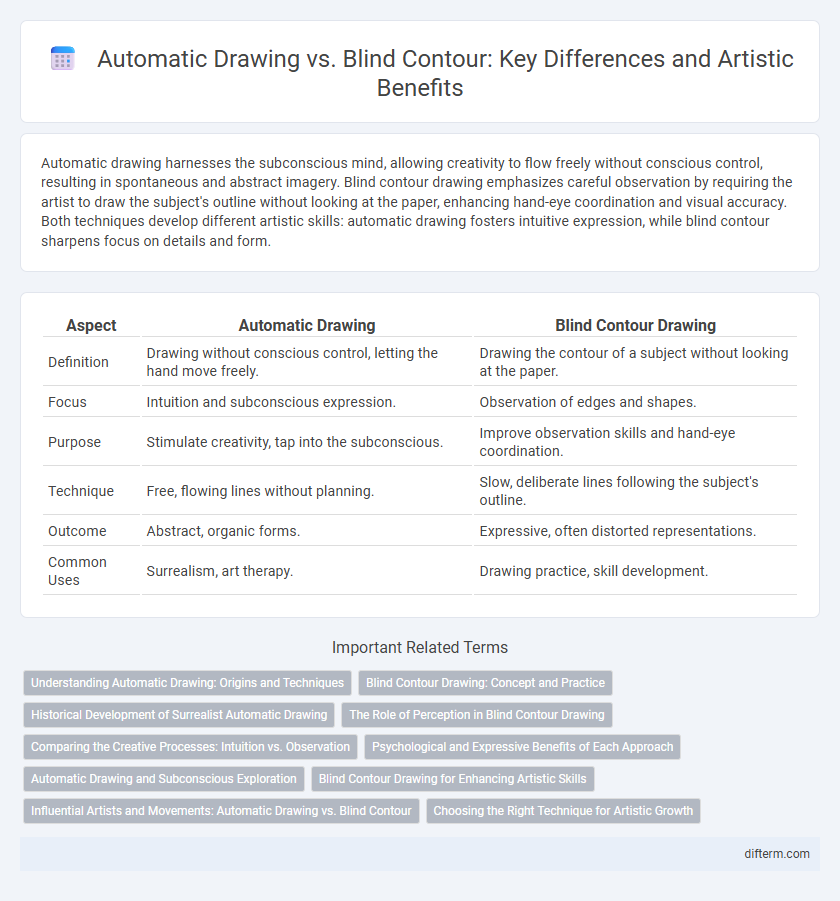Automatic drawing harnesses the subconscious mind, allowing creativity to flow freely without conscious control, resulting in spontaneous and abstract imagery. Blind contour drawing emphasizes careful observation by requiring the artist to draw the subject's outline without looking at the paper, enhancing hand-eye coordination and visual accuracy. Both techniques develop different artistic skills: automatic drawing fosters intuitive expression, while blind contour sharpens focus on details and form.
Table of Comparison
| Aspect | Automatic Drawing | Blind Contour Drawing |
|---|---|---|
| Definition | Drawing without conscious control, letting the hand move freely. | Drawing the contour of a subject without looking at the paper. |
| Focus | Intuition and subconscious expression. | Observation of edges and shapes. |
| Purpose | Stimulate creativity, tap into the subconscious. | Improve observation skills and hand-eye coordination. |
| Technique | Free, flowing lines without planning. | Slow, deliberate lines following the subject's outline. |
| Outcome | Abstract, organic forms. | Expressive, often distorted representations. |
| Common Uses | Surrealism, art therapy. | Drawing practice, skill development. |
Understanding Automatic Drawing: Origins and Techniques
Automatic drawing, rooted in Surrealist art, emphasizes subconscious creativity by allowing the hand to move freely without conscious control, unlocking deeper psychological insights. Originating in the early 20th century with artists like Andre Masson, this technique contrasts with blind contour drawing, which focuses on precise observation by drawing subjects without looking at the paper. Mastery of automatic drawing involves embracing spontaneity and trusting instinctual movements to reveal unique artistic expressions.
Blind Contour Drawing: Concept and Practice
Blind contour drawing emphasizes capturing the essence of a subject's form by drawing its outline without looking at the paper, enhancing hand-eye coordination and observational skills. This technique fosters intuitive mark-making and deepens the artist's ability to perceive shapes, contours, and proportions accurately. Regular practice of blind contour drawing builds confidence in freehand sketching and sharpens visual memory, making it a foundational exercise in art education.
Historical Development of Surrealist Automatic Drawing
Surrealist automatic drawing originated in the early 20th century, spearheaded by artists such as Andre Breton and Andre Masson as a method to bypass conscious control and tap into the unconscious mind. This technique evolved from Dadaism and was pivotal in developing the Surrealist movement's emphasis on spontaneity and dream imagery. Unlike blind contour drawing, which primarily trains observational skills by drawing without looking at the paper, automatic drawing focuses on freeing creative expression through unmediated marks and psychic automatism.
The Role of Perception in Blind Contour Drawing
Blind contour drawing emphasizes the role of perception by training artists to closely observe their subject without looking at the paper, which enhances hand-eye coordination and visual accuracy. This method prioritizes capturing the essence and proportions of the subject through continuous observation rather than relying on preconceived ideas or memory. The process sharpens perceptual skills, helping artists develop a deeper connection between what they see and how they translate it onto the drawing surface.
Comparing the Creative Processes: Intuition vs. Observation
Automatic drawing taps into the subconscious by allowing spontaneous, uninhibited mark-making, fostering creativity driven by intuition and emotional release. Blind contour drawing emphasizes focused observation, requiring artists to closely study the subject without looking at the paper, which enhances hand-eye coordination and sharpens perceptual skills. Both methods uniquely engage different cognitive pathways, one unlocking inner impulses, the other strengthening external visual accuracy.
Psychological and Expressive Benefits of Each Approach
Automatic drawing enhances access to the subconscious mind, promoting emotional release and fostering creativity by bypassing the rational mind, which can lead to profound self-discovery and therapeutic effects. Blind contour drawing sharpens intense observation skills and heightens hand-eye coordination, encouraging artists to capture the essence of their subject with raw, unfiltered expression that often conveys vulnerability and immediacy. Both techniques offer unique psychological benefits: automatic drawing taps into intuition and inner emotions, while blind contour drawing cultivates mindfulness and present-moment awareness, enriching artistic expression.
Automatic Drawing and Subconscious Exploration
Automatic drawing unlocks the subconscious mind by allowing spontaneous, unfiltered marks to emerge on the paper, bypassing rational control and tapping into hidden thoughts and emotions. This technique encourages deep psychological exploration, making it a powerful tool for artists to access inner creativity and unconscious processes. Unlike blind contour drawing, which emphasizes observational accuracy, automatic drawing prioritizes intuition and free association to reveal subconscious imagery.
Blind Contour Drawing for Enhancing Artistic Skills
Blind contour drawing sharpens observational skills by forcing artists to closely study and replicate the subject without looking at the paper. This technique enhances hand-eye coordination and encourages a deeper connection between sight and motor function, resulting in more accurate and expressive artwork. Practicing blind contour drawing regularly can significantly improve an artist's ability to capture intricate details and develop a unique, dynamic style.
Influential Artists and Movements: Automatic Drawing vs. Blind Contour
Automatic drawing, championed by Surrealists like Andre Masson, emphasizes subconscious expression and spontaneity, reflecting the movement's fascination with the unconscious mind. Blind contour drawing, favored by artists such as Pablo Picasso during his exploration of Cubism, focuses on keen observation and the accuracy of line without visual feedback. Both techniques significantly influenced modern art by challenging traditional approaches to representation and creativity.
Choosing the Right Technique for Artistic Growth
Automatic drawing fosters spontaneous creativity by bypassing conscious control, allowing subconscious imagery to surface, which is essential for exploring inner emotions and abstract concepts. Blind contour drawing emphasizes hand-eye coordination and observational skills by forcing artists to focus solely on the subject's outlines without looking at their paper, enhancing precision and detail recognition. Selecting the right technique depends on artistic goals: automatic drawing suits emotional expression and subconscious exploration, while blind contour strengthens foundational drawing skills for realistic representation.
automatic drawing vs blind contour Infographic

 difterm.com
difterm.com